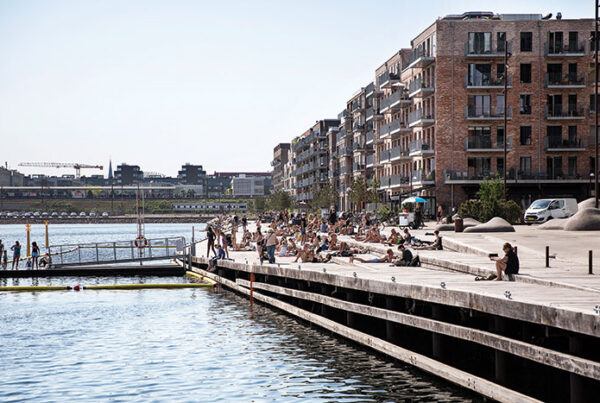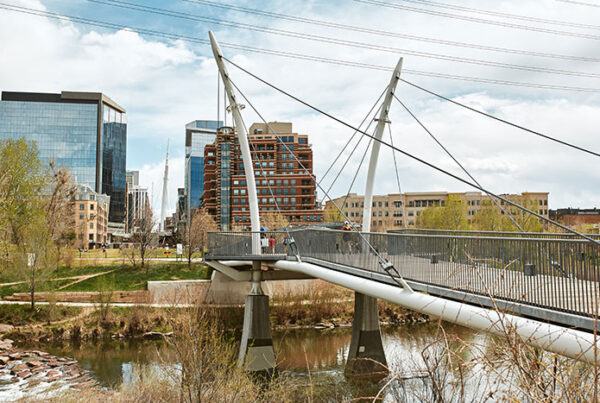Despite the wide availability of energy efficiency (EE) technology, the inconveniences associated with retrofitting a building have led to staggering lags in adoption. Currently, EE upgrades are often approached as standalone retrofits, which are time-consuming, disruptive, costly, and—no pun intended—inefficient.
As one property manager put it, “If I have to justify five different things, that’s a lot of approval time.” For office buildings, in particular, coordinating efficiency retrofits, especially if done one at a time, can seem like more trouble than it’s worth. As one architect reports, “Time is almost always a constraint and typically everybody’s behind the eight ball.” But, with climate change worsening every day, the movement to decarbonize buildings and reach net zero must overcome these resource challenges.
Introduction to Integrated System Packages
Streamlining the retrofit process is a crucial element in widening the hoop to enable more commercial buildings to undergo upgrades. One way to improve the process and accelerate the adoption of EE technologies is to incorporate deeper EE retrofits into regular real estate life-cycle events such as renovations, equipment replacement, and lease fit-outs. As one developer states, “there’s a three- to four-week window” during which key capital planning decisions are made, emphasizing the tight time crunch for building construction, while another argues that energy plans should be entirely integrated with capital plans. But, integrated approaches and deeper savings still require significant engineering expertise and have transaction cost problems; quasi-standardized solutions can help reduce some of the burdens in design, specification, and commissioning.
Integrated System Packages (ISPs), developed by Lawrence Berkeley National Laboratory (LBNL) and sponsored by the Department of Energy, are packaged efficiency solutions to be incorporated into the real-estate cycle (Figure 1). ISPs reduce transaction costs for building owners and mitigate disruptions to building occupants. As one property manager put it, “the capital threshold for implementing changes is more favorable when demo is ongoing: ceiling opened up, something else torn up, or don’t have to maintain HVAC operations … it’s easy to add energy efficiency when electricians are already there for some reason.” Because contractors are already in place for a routine renovation, the incremental costs to add on ISPs for efficiency are minimized.
LBNL has developed ISPs for three common real estate events (Figure 2): tenant fit-out, rooftop unit (RTU) replacement, and whole building renovation (e.g. when a building is being re-positioned from class B to class A). Toolkits for these ISPs are available at https://buildings.lbl.gov/cbs/isp, and include template specifications, applicability guides, functional test protocols, and more.

Examples of ISPs timed to events in the real estate lifecycle.
Journey to Net Zero
As climate change worsens and the building sector works to decrease its carbon footprint, more states and municipalities are moving toward net-zero building goals. While ISP retrofits are not net zero in themselves, they enable a building to move forward on its journey to net zero by increasing the feasibility of broad efficiency upgrades for building owners—the essential starting point in achieving a net zero building.
The Packages

Tenant Fit-Out
The Tenant Fit-Out ISP was tailored to the unique constraints of a small office tenant improvement project. This ISP adds minimal cost or disruption to building occupants because contractors are already on site for the tenant fit-out itself, and many of the costs are associated with the already-occurring baseline renovation.
For lighting upgrades, this package includes LED light fixtures, occupancy-based controls, and daylight dimming controls. The controls may use individual fixture-integrated sensors or a separate sensor network. For HVAC, this package includes ASHRAE Guideline 36 controls. ASHRAE Guideline 36 includes intermittent ventilation, zone sequences, demand-controlled ventilation, and trim-and-respond sequences for resetting supply air temperature and duct static pressure. Optionally and where appropriate, this package can also include a network lighting controls system, ceiling fans, plug load controls, and automated interior shades.
These measures were selected because they fit into the scope of medium-to-larger scale tenant fit-outs that cover lighting and HVAC controls. These upgrades do not require a lot of customization and are therefore easy to standardize.
The savings from Tenant Fit-Out implementation were measured through simulation (see chart below) and then validated by laboratory testing in LBNL’s FLEXLAB. Laboratory testing was conducted for three orientations (south, west, and interior) and showed 69-84 percent savings from lighting, 20-40 percent savings from HVAC, and 23-38 percent whole-building savings.

Tenant fit-out ISP simulation energy savings results. Whole-building energy savings range from 23 percent (Core package in Chicago) to 38 percent (CorePlus in San Francisco).

FLEXLAB testing of the Tenant Fit-out ISP
RTU Replacement
The second ISP option occurs when replacing a rooftop unit (RTU) HVAC system. This package includes a high-efficiency RTU, advanced controls based on ASHRAE Guideline 36, and energy monitoring. Optionally and where appropriate, the package also includes window films and cool roofs to reduce the RTU load and size, reducing cost and freeing up valuable roof space for other uses.
The simulation results showed 12-18 percent savings (see chart below), which were validated experimentally in LBNL’s FLEXLAB.
Building Renovation
The Building Renovation ISP can be used during any routine building upgrade. This package includes LED lighting and daylight dimming controls, high-efficiency RTUs, HVAC controls based on ASHRAE Guidelines 36, and energy monitoring. Optionally and where appropriate, the package also includes ceiling fans, window films, cool roofs, plug-load controls, and automated interior shades.
Simulations showed 25 percent-45 percent savings (see chart below).

Building Renovation ISP’s simulated energy savings results ranged from 25 percent (Core package in Chicago) to 45 percent (CorePlus in San Francisco).
Case Study: Adding Efficiency to Renovations in Birmingham, Alabama
CBRE, the world’s largest property and facilities management company, partnered with LBNL in the development of ISPs. As the manager of several buildings in the southeastern U.S., they saw an opportunity to pilot ISPs in a property that was planning a routine tenant fit-out. The building was a bank in Birmingham that was planning exterior lighting upgrades as well as rooftop solar PV installation.

Interior view of a bank in Birmingham, Alabama.
With the addition of the Tenant Fit-Out ISP, the scope of the project was expanded to include interior lighting upgrades, such as LED lighting and daylight-based dimming, and HVAC controls upgrades based on ASHRAE Guideline 36, such as static pressure reset, heating lockout, zone-bases scheduling, optimized start, and widening the deadband to 4°F.
The bank did not have energy monitoring software and was not large enough to justify its addition, so CBRE used interval meter data from the utility to analyze the building load for energy savings (see two charts below, showing daily and normalized energy use, pre- and post-retrofit).

Average daily energy use profiles, pre-retrofit (black dotted line) and post-retrofit (blue solid line).

Daily energy use and savings (normalized), showing pre-retrofit energy use (black dotted line) and post-retrofit energy use (blue solid line) and savings achieved (green solid line).
The entire retrofit achieved 25 percent energy savings, with about 6 percent from the exterior lighting upgrade and 19 percent from the additional ISP measures. These retrofit steps were also able to cut annual carbon emissions by roughly 33 percent, mostly due to the efficiency measures installed (see charts below).

Annual energy and GHG savings in Alabama bank pre- and post-retrofit, showing a 25 percent energy savings and 33 percent carbon emissions reduction.
Each ISP had template specifications to assist the contractors. For ASHRAE Guideline 36 HVAC controls, more customization and iteration were required because the applicability of measures depends on the specific HVAC system.
Since the tenant fit-out pilot in Birmingham, LBNL has developed an “ISP specifications generator toolkit” that builds customized ISP specifications given the specific characteristics of a building. As Chris Pelrine, director of energy sustainability at CBRE put it, “the ISP toolkits offer the ability for project developers and planners to easily apply energy efficient standards into the design specifications of the project. The toolkits will not only streamline project execution but will also allow the planner to estimate the energy savings. This will aid in the approval of any potential cost increase due to installing energy-efficient equipment.”
With the addition of the Tenant Fit-Out ISP to the existing lighting and solar upgrades, the Birmingham bank was able to achieve 19 percent higher energy and GHG savings than originally planned. The expanded scope led to minimal disruption and additional costs because contractors were already on site for the previously planned renovations. Future upgrades will be even easier given the development of the ISP specifications toolkit, which enables streamlined customization without the additional headache.
By integrating improved, standardized retrofit packages seamlessly into the real estate life cycle, ISPs reduce the high transaction costs, engineering expertise, and building occupant disruptions that are normally associated with building energy efficiency upgrades. As cities and states work to reduce the carbon emissions associated with the building sector and make progress towards a net zero industry, energy efficiency requirements will grow. With ISPs, efficiency upgrades no longer need to be disruptive standalone projects that break the bank for building owners. As a respondent from the ISP stakeholder engagement process noted, “what’s easy gets done,” and ISPs make efficiency easy.
This work was supported by the Assistant Secretary for Energy Efficiency and Renewable Energy, Building Technologies Program, of the U.S. Department of Energy under Contract No. DE-AC02-05CH11231. The authors would like to thank Molly Bertolacini for her support in writing this article.
DOUG DAVENPORT is founder and executive director, ProspectSV. PAUL MATTHEW is a staff scientist and department head of Whole Building Systems at Lawrence Berkeley National Laboratory.



